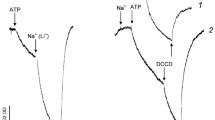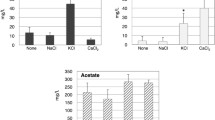Abstract
The Na level inside cells of Anacystis nidulans is lower than in the external medium reflecting an effective Na extrusion. Na efflux is an active process and is driven by a Na+/H+-antiport system. The necessary H+-gradient is generated by a proton translocating ATPase in the plasmalemma. This ATPase (electrogenic proton pump) also produces the membrane potential (about -110 mV) responsible for K accumulation. N,N′-dicyclohexylcarbodiimide (DCCD) inhibits the ATPase and the H+-gradient completely, but the membrane potential is only reduced (<-70 mV), since K efflux initiated by DCCD maintains the potential partly by diffusion potential.
With DCCD, active Na efflux is inhibited thus revealing Na uptake and leading by equilibration to the membrane potential to a 5–20 fold accumulation. Na uptake depends on the DCCD concentration with an optimum at (1–2)×10-4 M DCCD. Pretreatment with DCCD for a few minutes followed by replacement of the medium suffices to induce Na uptake.
DCCD induced Na influx is about 5 times faster in light than in darkness, and the steady state is reached much earlier in light; a 5 fold increase by light was also found for Rb uptake with untreated cells. Valinomycin stimulates the influx of Rb to about the same rate in light and dark. Therefore light may unspecifically increase the permeability of the plasma-lemma probably via the ATP level. Similarly to DCCD also 3×10-3 M N-ethylmaleimide induces Na uptake.
Similar content being viewed by others
Abbreviations
- DCCD:
-
N,N′-dicyclohexylcarbodiimide
- NEM:
-
N-ethylmaleimide
- CCCP:
-
carbonylcyanide m-chlorophenylhydrazone
- Pipes:
-
piperazine-N,N′-bis(2-ethanesulfonic acid)
- DCMU:
-
3-(3,4-dichlorophenyl)-1,1-dimethylurea
References
Altendorf, K., Hirata, H., Harold, F. M.: Accumulation of lipid-soluble ions and of rubidium as indicators of the electrical potential in membrane vesicles of Escherichia coli. J. biol. Chem. 250, 1405–1412 (1975)
Bisalputra, T., Brown, D. L., Weier, T. E.: Possible respiratory sites in a blue-green alga Nostoc sphaericum as demonstrated by potassium tellurite and tetranitro-blue tetrazolium reduction. J. Ultrastruct. Res. 27, 182–197 (1969)
Bornefeld, T., Simonis, W.: Effects of light, temperature, pH, and inhibitors on the ATP level of the blue-green alga Anacystis nidulans. Planta (Berl.) 115, 308–318 (1974)
Dewar, M. A., Barber, J.: Cation regulation in Anacystis nidulans. Planta (Berl.) 113, 143–155 (1973)
Harold, F. M.: Chemiosmotic interpretation of active transport in bacteria. Ann. N.Y. Acad. Sci. 227, 297–311 (1974)
Harold, F. M., Baarda, J. R., Baron, C., Abrams, A.: Dio-9 and chlorohexidine: inhibitors of membrane-bound ATPase and cation transport in Streptococcus faecalis. Biochim. biophys. Acta (Amst.) 183, 129–139 (1969a)
Harold, F. M., Baarda, J. R., Baron, C., Abrams, A.: Inhibition of membrane-bound ATPase and cation transport in Streptococcus faecalis by N,N′-dicyclohexylcarbodiimide. J. biol. Chem. 244, 2261–2268 (1969b)
Harold, F. M., Papineau, D.: Cation transport and electrogenesis by Streptococcus faecalis. I. The membrane potential. J. Membrane Biol. 8, 27–44 (1972a)
Harold, F. M., Papineau, D.: Cation transport and electrogenesis by Streptococcus faecalis. II. Proton and sodium extrusion. J. Membrane Biol. 8, 45–62 (1972b)
Klein, W. L., Boyer, P. D.: Energization of active transport by Escherichia coli. J. biol. Chem. 247, 7257–7265 (1972)
Kratz, W. A., Myers, J.: Nutrition and growth of several blue-green algae. Amer. J. Bot. 42, 282–287 (1955)
Maloney, P. C., Wilson, T. H.: ATP synthesis driven by a proton-motive force in Streptococcus lactis. J. Membrane Biol. 25, 285–310 (1975)
McCarty, R. E., Pittman, P. R., Tsuchiya, Y.: Light-dependent inhibition of photophosphorylation by N-ethylmaleimide. J. biol. Chem. 247, 3048–3051 (1972)
Palek, J., Stewart, G., Lionetti, F. J.: The dependence of shape of human erythrocyte ghosts on calcium, magnesium and adenosine triphosphate. Blood 44, 583–597 (1974)
Paschinger, H.: NaCl stimulated respiration with Anacystis nidulans. Z. allg. Mikrobiol. (in press, 1977)
Schmetterer, G.: Zn-Aufnahme durch Erythrozyten-Ghosts. Thesis, University of Vienna (1976)
Tromballa, H. W., Broda, E.: Der freie Raum synchroner Chlorella. Arch. Mikrobiol. 86, 281–290 (1972)
West, I. C., Mitchell, P.: Proton/sodium ion antiport in Escherichia coli. Biochem. J. 144, 87–90 (1974)
Wittig, G., Schöllkopf, U.: Über Triphenylphosphinmethylene als olefinbildende Reagenzien. Chem. Ber. 87, 1318–1330 (1954)
Author information
Authors and Affiliations
Rights and permissions
About this article
Cite this article
Paschinger, H. DCCD induced sodium uptake by Anacystis nidulans . Arch. Microbiol. 113, 285–291 (1977). https://doi.org/10.1007/BF00492037
Received:
Issue Date:
DOI: https://doi.org/10.1007/BF00492037




